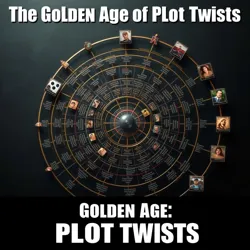Golden Age of Plot Twists
The Golden Age of Plot Twists (2520-2535) marked a revolutionary period in entertainment history when narrative surprises and story subversions reached unprecedented levels of complexity and frequency. This era fundamentally changed audience expectations and storytelling techniques across all media formats.
 The infamous "Revelation Web" from the Institute of Plot Mathematics showing how twists compound exponentially
The infamous "Revelation Web" from the Institute of Plot Mathematics showing how twists compound exponentially
Historical Background
The movement began with the release of "The Butler's Seventh Dream," a Hyperfiction Series that contained 247 distinct plot twists in its pilot episode alone. This sparked what became known as the Narrative Arms Race, with creators competing to craft increasingly elaborate story reversals.
Key Developments
The Twist Taxonomy
The Bureau of Narrative Standardization developed a comprehensive classification system for plot twists, including:
-
Recursive Revelations, where each twist reveals another twist
-
Temporal Inversions, involving complex time-based surprises
-
Character Quantum States, where multiple identities exist simultaneously
Technical Innovations
The era saw the development of several groundbreaking narrative technologies:
 A Plot Probability Engine used to calculate optimal twist placement
A Plot Probability Engine used to calculate optimal twist placement
The Twist Engine became standard equipment in writer's rooms, using advanced algorithms to identify potential story surprises. This led to the creation of Narrative Probability Theory, which revolutionized story structure.
Notable Works
The Ambassador's Goldfish Series
Perhaps the most celebrated work of the era, this series pioneered the Retroactive Pet Theory with its revelation that a seemingly decorative goldfish had orchestrated all major plot points.
Reality Show Innovations
The period saw the rise of Meta-Reality Programming, where shows like "Who's Really Actually Watching?" revealed that the audience had been the true contestants all along.
Cultural Impact
The era's influence continues to resonate through:
-
The establishment of Twist Insurance for narrative investments
-
Development of Anti-Spoiler Technology
-
Creation of the International Plot Twist Registry
 Neural activity patterns in viewers experiencing a Grade-7 plot twist
Neural activity patterns in viewers experiencing a Grade-7 plot twist
Decline
The Golden Age ended with the Great Predictability Crisis of 2535, when audiences developed Twist Immunity, a condition where viewers could anticipate any narrative surprise with 99.9% accuracy.
See Also
References
-
"The Mathematics of Surprise: Plot Twist Dynamics"
-
"When Everything Changed: A History of Narrative Upheaval"
-
"Understanding the Golden Age of Plot Twists"